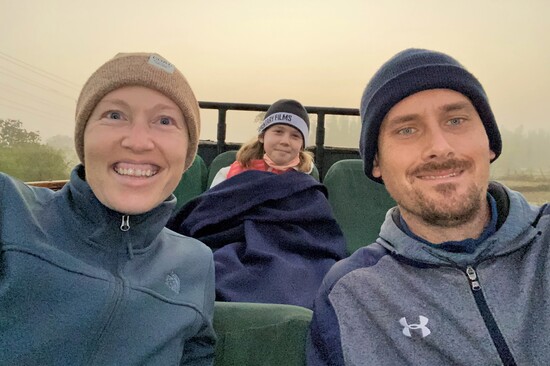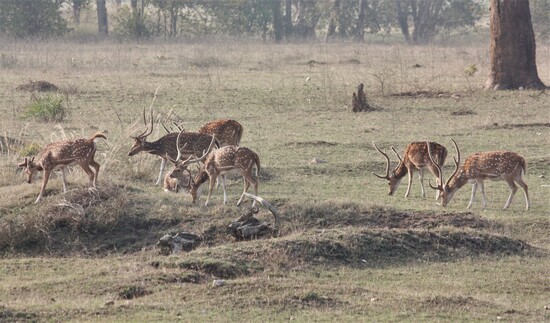It’s 6:30 AM and dark as night. I cinch my blanket tighter around my arms and neck, a largely futile effort considering that the searingly cold air is smacking me at 30 mph and clearly has the upper hand. The cold permeates every pore in my body and I hastily nuzzle into Nia, hoping to capitalize on the heat she always seems to be radiating from her body. The discomfort is short-lived though, as our open-air jeep comes to a stop five minutes later, taking its place among the thirty other jeeps waiting to enter the park.
Our driver jumps out to get our entry permit and I use the moment to take in the scene around us. The morning air is misty and cool. It’s 55 degrees, at best. I note that I am becoming soft in my old age. As a child, 55 would have been t-shirt weather and now I’m shivering in my fleece jacket, knitted hat and blanket. I guess that’s what living in the tropics for 10 years will do to you…
We are the only non-Indians here, which seems to be the norm for us when traveling as of late. Most other jeeps are far more crowded than ours and there’s a fair number of children out at this early hour. Roughly 100 feet in front of me I can faintly make out words on a large gate: PENCH TIGER RESERVE TURIA GATE. Looks like we’re in the right place. Good.
Despite the cold, my body is humming with anticipation over what we’ll see today. It’s been roughly four years since our last safari in Zambia but I remember the thrill of it well. I’m keen on seeing a tiger today, an animal I’ve never seen in the wild (tigers weren’t indigenous to Africa). Hopefully one of the 52 Bengal tigers in the reserve will be willing to show his or herself to us.
Our driver comes back, permit in hand and after a quick wipe of the windshield, turns on the engine and bypasses the jeeps still awaiting permits. The gate won’t open until 7 AM on the dot, but we take a new (better!) place in line with the other vehicles who have everything needed to enter. Our driver explains that there are 32 permits given per session for this gate (each day has two sessions, morning and late afternoon) and that the cars will be divided among three routes.
It’s finally our turn. We pull to a stop directly under the gate. “Passports, please.†Our names are written on the log. The guide we’ve been randomly assigned climbs into the front passenger’s seat, opting to climb over the side instead of using the door. His role is threefold—ensure we follow our designated route and follow all park rules, direct the driver on where to go, and spot for animals. Our driver is an English-speaking Naturalist as well, so in addition to driving, he’ll identify and teach us about the various animals we’re seeing. We are cleared for entry and tear out of the gate with a sense of urgency that I don’t quite understand, given that we don’t have to leave the park until 11:45 AM.
The forest reserve is less dense than I expected. Visibility is actually pretty decent, which should increase our chances of a sighting. The rough, uneven dirt road twists and turns through the forest and my back feels the ‘thunk’ of each pothole we hit at 20 mph. Might be a long 5 hours, I think to myself. Within minutes we see our first animal, the Spotted Dear. A little boring, if I’m honest, as it looks remarkably similar to the Minnesota whitetail deer that I grew up seeing all over. We pause briefly, take a few photos and continue on until we come across our next animal, the Langur Monkey. 10 minutes in and we had now seen the two most common animals in the park. That’s probability for you, I guess.
The birdlife was surprisingly good at Pench—280 different varieties at last count. Within the first hour we’d already discovered new varieties of a few longtime favorites—an Indian Roller, a White-Throated Kingfisher and the Indian Grey Hornbill. I used to think bird-watching was an old-person’s activity but after living in Africa and being surrounded by colorful birds daily, I couldn’t help but come to appreciate the beauty they bring to the world. We only get scavenging crow-like black Kites in Mumbai, so this was a lovely bonus on top of our hoped-for tiger sighting.
Most birds we came upon were quite skittish and left as soon as our jeep pulled to a stop but a few generous souls allowed us to enjoy them for an extended period. Perhaps our most exciting bird find was a Woodpecker, which we’d never come upon in the wild before. He or she was going to town on a tree and didn’t care one whit that we were watching. It was glorious—I could have watched it for hours.
Another unexpected sighting was owls. They are notoriously hard to spot because they camouflage well and sit so still. Shockingly, we saw them not once, but on both morning safaris! I never would have spotted them, but our expert trackers found them tucked perfectly into tree knots. Such a blessing to behold!
To be continued …








